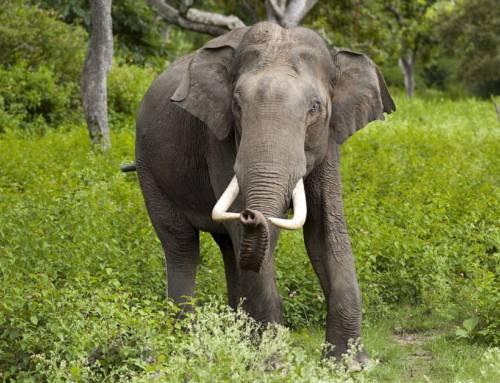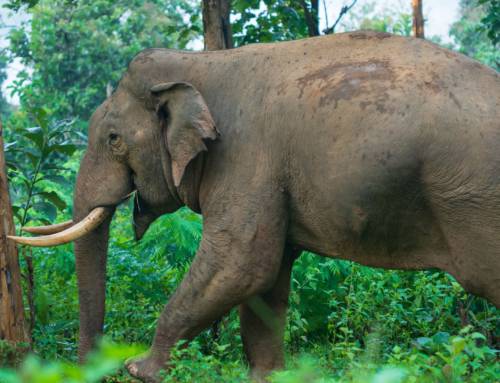Research Article: Vasudev, D., Goswami, V. R., Srinivas, N., Syiem, B. L. N., & Sarma, A. (2021). Identifying important connectivity areas for the wide‐ranging Asian elephant across conservation landscapes of Northeast India. Diversity and Distributions, 27(12), 2510-2526.
Blog Author: Deep Gogoi
Key Highlights:
- Scientists have mapped elephant movement corridors across an area of 21,210 square kilometers in Northeast India, utilizing insights from over 1,180 residents.
- The study reveals that elephants intentionally navigate through a variety of environments, including forests, tea plantations, and farmlands, rather than restricting themselves solely to forested areas.
- Researchers have identified tea plantations and closed-canopy forests as safer routes that facilitate elephant movement in areas dominated by human activity.
- The study also uncovered overlaps between elephant pathways and conflict zones, underscoring the importance of developing coexistence strategies.
- The authors emphasize the need for wildlife-friendly infrastructure and community-based land-use planning to ensure that both elephant conservation and local livelihoods can thrive.
In the lush landscapes of Northeast India, a remarkable ecological story is unfolding. Scientists have refined and quantified pathways that may help endangered Asian elephants navigate across a vast 21,210 square kilometre region, revealing how these gentle giants move between forests, plantations, and agricultural areas. This research, based on modeling movement probabilities, offers hope for protecting elephant populations in this biodiverse landscape.
The research team interviewed over 1,180 local residents, primarily farmers, across Assam and surrounding areas to track elephant presence and movement patterns. This citizen science approach proved invaluable, as elephants are easily recognizable and many local community members have knowledge of their behavior. have intimate knowledge of their behavior. The study focused on understanding how elephants use the “matrix” – the non-forest areas between protected habitats that include agricultural fields, tea and other plantations, and human settlements.
What emerged was that elephants didn’t just stick to forests. They actively use tea plantations and closed-canopy plantations more frequently than open agricultural areas. Overall, the research found that locations with abundant vegetation cover, proximity to forests, and lower human population density showed a higher probability of elephant use for movement.
The study mapped critical connectivity areas across three major conservation landscapes, including the renowned Kaziranga-Karbi Anglong Elephant Reserve, home to an estimated 1,746 elephants. These corridors provide elephants with multiple options for movement, allowing them to navigate human-modified landscapes to find food, water, mates, and seasonal resources.
Unlike simple forest paths, these corridors represent a complex network where elephants demonstrate movement patterns suggesting partial landscape knowledge. Rather than wandering randomly, the modeling results suggest elephants move with some awareness of their landscape. The best-supported model (θ = 0.1) indicated movement with partial information rather than purely random or least-cost pathways. This interpretation is supported by elephant memory and perception literature from other studies, which document their ability to retain spatial information and learn from conspecifics.
The research identified both promising opportunities and concerning threats. While forests remain the primary pathways for elephant movement, the agricultural matrix plays a surprisingly important supporting role. Tea plantations and closed-canopy plantations provide better movement opportunities than open crop fields. However, the study also revealed troubling overlap between elephant movement corridors and human-elephant conflict zones. Areas where elephants frequently travel often coincide with locations where crop damage and property destruction occur, creating tensions between conservation needs and community livelihoods.
The expanding network of roads and railways poses another significant challenge. As Northeast India develops its infrastructure, these linear barriers could fragment elephant populations and increase road mortality. The research highlights the need for wildlife-aware infrastructure planning that incorporates connectivity considerations and corridor protection measures. What makes this research particularly valuable is its reliance on local knowledge and community participation. By working with farmers and residents who encounter elephants regularly, scientists gained insights across spatial and temporal scales that would be challenging to achieve through telemetry alone due to cost and logistical constraints. This approach not only provides better data coverage but also demonstrates the value of crowd-sourced information for landscape-scale modeling.
The study demonstrates that effective elephant conservation requires understanding the complex relationship between wildlife and human-modified landscapes. Success depends on maintaining forest corridors while also improving the permeability of agricultural areas to elephant movement, creating a mosaic of habitats that benefits both elephants and people.
This research provides a roadmap for landscape-scale elephant conservation that goes beyond simply protecting forests. It calls for integrated approaches that consider the entire ecosystem, from protected parks to tea plantations to village boundaries. By mapping these connectivity areas with refined spatial detail, conservationists can now target their efforts more effectively.
The findings suggest that with thoughtful planning and community cooperation, it’s possible to maintain elephant populations while mitigating conflict impacts. The paper suggests that targeted interventions in the matrix, such as plantation management practices and agricultural strategies, could potentially balance movement needs with conflict mitigation, though empirical outcomes remain to be demonstrated. Infrastructure development can be designed with connectivity considerations to facilitate rather than hinder elephant movement.
As climate change and development pressures continue to reshape Northeast India’s landscapes, this research offers crucial insights for maintaining the delicate balance between human needs and wildlife conservation. The key lies in recognizing that elephants and people share this landscape, and success depends on solutions that work for both.
Keywords:
Asian elephant conservation, wildlife corridors, landscape connectivity, Northeast India, Assam, Kaziranga National Park, human-elephant conflict, tea plantations, agricultural matrix, community-based conservation, endangered species, habitat fragmentation, wildlife movement, elephant reserves, conservation planning
To access the original article, click here.




